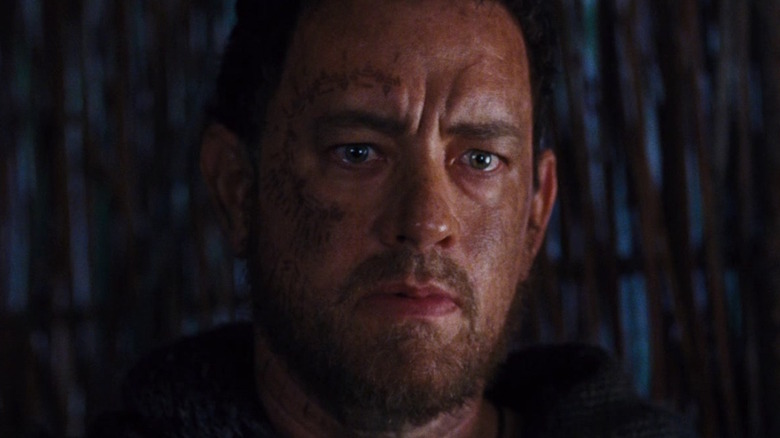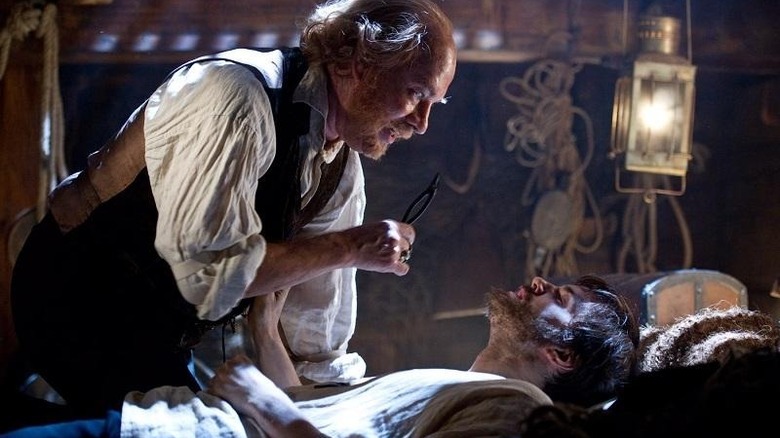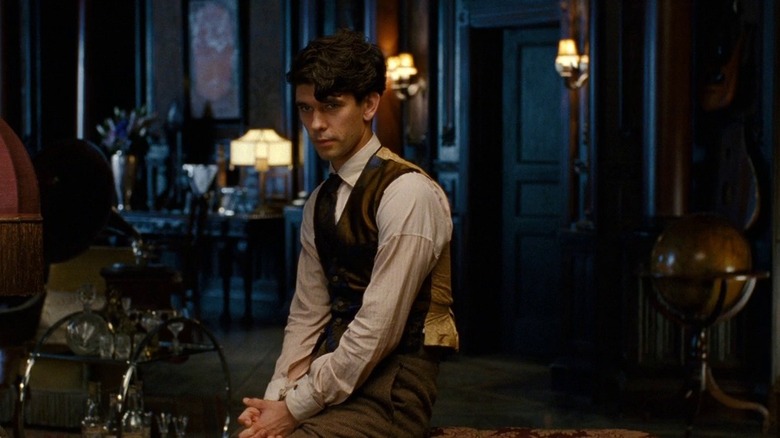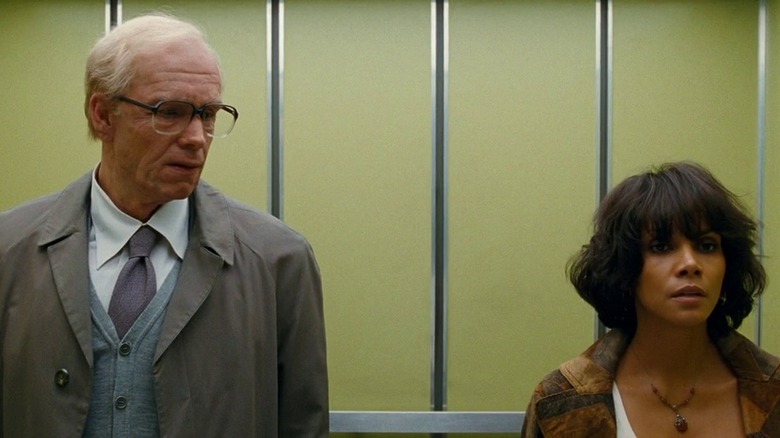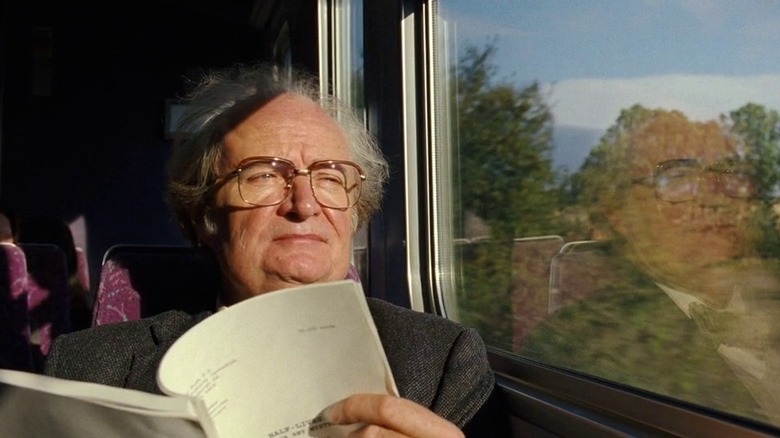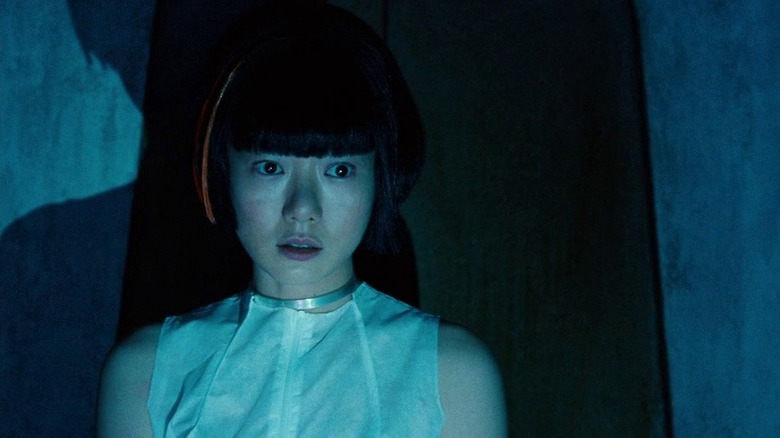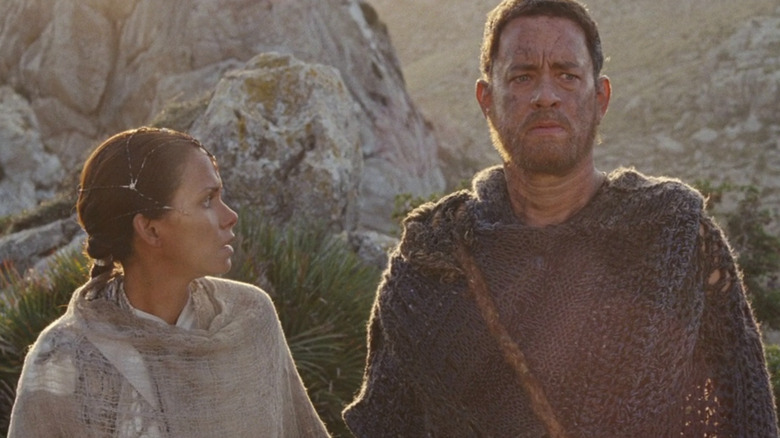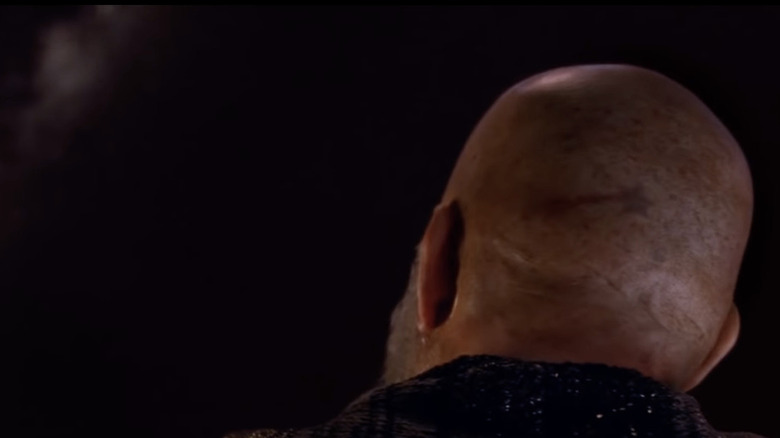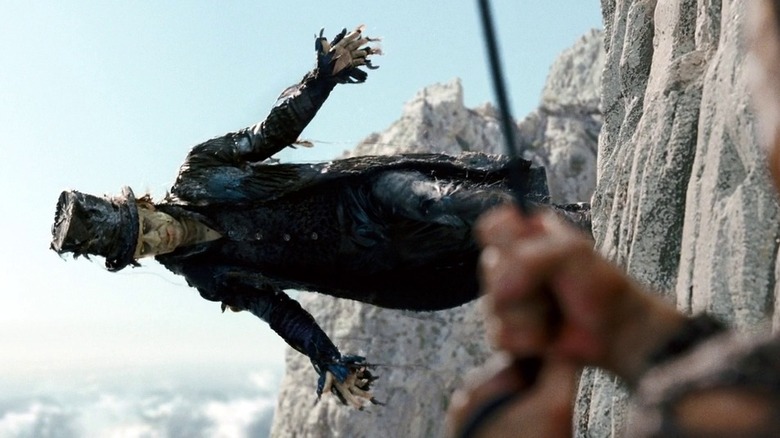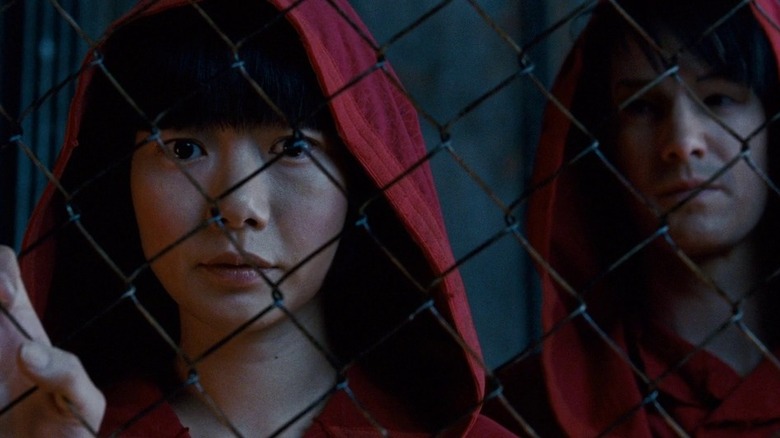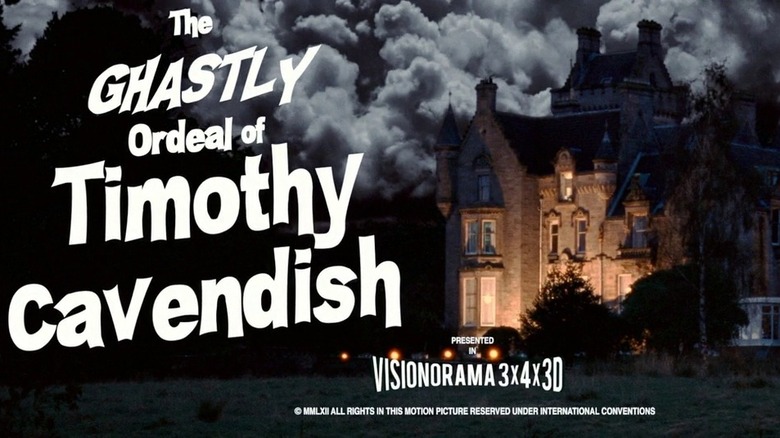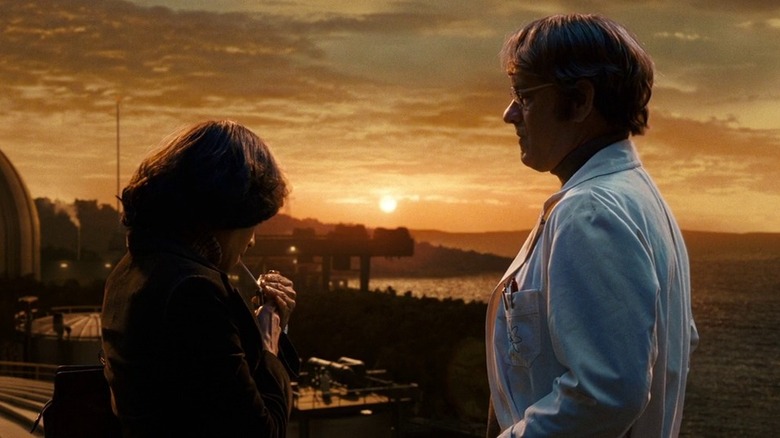The Ending Of Cloud Atlas Explained
Published in 2004, David Mitchell's epic "Cloud Atlas" was considered an "unfilmable" novel (even by the author himself), thanks to its spanning of generations and nonlinear storytelling. But it didn't actually take long for a movie adaptation to grace screens, thanks to the astounding talents of "The Matrix" franchise's Wachowski sisters and their frequent collaborator Tom Tykwer, a German director and composer. Amazingly, the movie even follows the book's structure and myriad plots often to the letter (pun intended — it's partly an epistolary novel), making this cinematic opus an achievement on so many levels.
"Cloud Atlas" spans hundreds of years, exploring a group of connected souls that reincarnate into different forms over generations, from 1849 all the way past 2321. Utilizing the same actors in multiple roles, we see how the sometimes big, and oftentimes small actions of just one person can have a ripple effect on so many way into the future. "Cloud Atlas" weaves each story and each generation out of sequence, showing us how time itself is relative, and illustrating the organic ways in which both personal and generational memory are created.
With all of these moving parts and an almost 3-hour runtime, "Cloud Atlas" can be disorienting at first watch. So, from womb to tomb and comet birthmarks, here is the ending of "Cloud Atlas" explained, broken down chronologically by each of the story's eras.
Note that there are major spoilers ahead.
Pacific Islands, 1849
While "Cloud Atlas" actually opens a few decades after 2321, its first story-within-a-story begins in the Pacific Islands with opportunistic scavenger Dr. Goose (Tom Hanks) and naive young barrister Adam Ewing (Jim Sturgess). Ewing's father-in-law Haskell Moore (Hugo Weaving) has made a deal with the sadistic Reverend Horrox (Hugh Grant) to bring enslaved local islanders from Chatham Islands to San Francisco. Ewing has been tasked with overseeing this human trafficking enterprise, but when he witnesses the brutal whipping of the enslaved Autua (David Gyasi), he is no longer sure he supports his father-in-law's terrible designs. Meanwhile, Dr. Goose has a brief moment with a local Moriori woman (Halle Berry), which quietly sets the stage for their future soul connections.
When Autua frees himself and stows away on board the ship, he and Ewing become friends and allies, and Autua proves himself as a valuable sailor on board, which solidifies his freedom. Without Autua's friendship, Ewing would have been poisoned to death by Dr. Goose, who wants the young lad out of the way, so he can steal his trove of gold coins. Autua saves Ewing from Dr. Goose. So, Ewing finally arrives in San Francisco and makes it safely into the arms of his wife Tilda (Doona Bae), he burns up the Reverend's slavery contract. The lovers leave to join the abolition movement back East.
Other core cast members in this era include Jim Broadbent as the ship captain, Ben Whishaw as a cabin boy, Keith David as Horrox's servant Kupaka, and Susan Sarandon as Horrox's early feminist wife.
England, 1936
Adam Ewing keeps a diary of his ordeal, which gets published as "The Pacific Journal of Adam Ewing." In 1936, young, bisexual musical rake Robert Frobisher (Ben Whishaw) finds himself captivated by Ewing's tale. The only problem is, half of the book is missing; so, he never gets to find out what happened to the intrepid Ewing. Frobisher currently lives in the manor estate of Vyvyan Ayres (Jim Broadbent) as an amanuensis — a composer's transcriptionist — where he is also working on his own symphony, "The Cloud Atlas Sextet."
Frobisher has left behind his lover Rufus Sixsmith (James D'Arcy), but writes him beautiful letters about his misadventures in the Ayres house and the experience of working with the narcissistic and cruel Ayres. Frobisher has an affair with Vyvyan's wife Jocasta (Halle Berry), and finds out she had previously been engaged to Tadeusz Kesselring (Hugo Weaving), who refused to marry her because she's Jewish and he's a Nazi.
Vyvyan Ayres is insufferable, and when he tries to claim the "Cloud Atlas Sextet" as his own by using Frobisher's sexuality to blackmail him, Frobisher shoots him and flees. Ayres survives and Frobisher is now a wanted man with no future, at least in his own estimation. He leaves his masterpiece "Cloud Atlas Sextet" to the love of his life, Sixsmith, and kills himself using Vyvyan Ayres' pistol, after seeing his love one last time.
Tom Hanks appears as the greedy hotel keep, who hustles Frobisher out of his prized silk waistcoat (a gift from Sixsmith), Jim Sturgess plays a poor tenant, and Hugh Grant plays a hotel clerk at a fancy hotel, where Frobisher and Sixsmith have their last affair.
If you or anyone you know is having suicidal thoughts, please call the National Suicide Prevention Lifeline at 1-800-273-TALK (8255).
San Francisco, 1973
Rufus Sixsmith not only gets Frobisher's "The Cloud Atlas Sextet" published, but also made into an actual recording, which journalist Luisa Rey (Halle Berry) tracks down after a chance meeting with Sixsmith in 1973. She becomes obsessed with "The Cloud Atlas Sextet," which perhaps isn't a surprise. After all, Luisa and Frobisher had an affair in their past lives, so there's something bigger or even cosmic drawing her to this music.
In the years since Frobisher's death, Sixsmith has become a well-known scientist, and he now is prepared to whistleblow on a faulty nuclear plant outside San Francisco. He notices Luisa has the same comet birthmark as Frobisher, and when he shows her a photo of his family, his brother is played by Jim Sturgess and his sister-in-law is Doona Bae (who played Adam Ewing and his wife Tilda in the 1849 section).
The oil lobbyist Lloyd Hooks (Hugh Grant) actually wants there to be a devastating nuclear mishap to bolster oil sales, so he sends Bill Smoke (Hugo Weaving) to assassinate Sixsmith, who's about to give Luisa proof of the issues with the plant. Sixsmith gets killed, and Luisa begins investigating his death. At the same time, she finds Frobisher's gorgeous letters to Sixsmith, and meets Dr. Isaac Sachs (Tom Hanks). She and Sachs have an instant connection, but he's killed when Smoke plants a bomb on his airplane. Hooks and Smoke are determined to cover all traces of this conspiracy, so Smoke goes after Luisa next, and nearly kills her by running her car off a bridge. Luisa seeks help from Joe (Keith David), a friend of her father Lester (played by Autua actor David Gyasi), and Smoke tries to kill them both. Finally, Luisa and her allies prevail, and she returns all of Sixsmith's papers to his beloved niece Megan (Zhu Zhu).
Doona Bae also appears as the Mexican foreman of a factory, and Frobisher actor Ben Whishaw appears as the groovy record store owner, who finds the rare recording of "The Cloud Atlas Sextet."
London, 2012
Decades later in London, we discover that Luisa Rey's spunky young neighbor Javier Gomez (Brody Nicholas Lee) has written a novel called "Half-Lives: A Luisa Rey Mystery," which is under consideration by Timothy Cavendish (Jim Broadbent), an obsequious literary agent. Cavendish's life descends into chaos when one of his authors — the gangster-turned-novelist Dermot Hoggins (Tom Hanks) — throws a harsh critic off the roof at a book party. Before Dermot commits murder, though, he has meaningful eye contact with an Indian woman in a sari (Halle Berry), but it doesn't stop his crime.
If that weren't bad enough, Dermot decides to extort Cavendish for £50,000. So, Cavendish turns to his wealthy (but estranged) brother Denholme (Hugh Grant), although the two of them are on the outs for good reason. Timothy had an affair with Denholme's wife Georgette (Ben Whishaw), so Denholme finally gets his revenge by tricking Timothy and permanently committing him to Aurora House, an old folks' home run by the sadistic Nurse Noakes (Hugo Weaving). Timothy orchestrates a "jail" break with several other captives, similarly abandoned by their families, and turns the escapades into a book, "The Ghastly Ordeal of Timothy Cavendish," which is adapted into a movie in 2062. The role of Timothy is played by Tom Hanks.
During his intake at the nursing home, Cavendish tries (unsuccessfully) to leave and declares, "I will not be subjected to criminal abuse!" It's a line that gets repeated both in his book and film adaptation, and continues traveling across time in surprising ways (which we'll detail later).
Timothy also reconnects with his first love Ursula (Susan Sarandon), and Jim Sturgess appears as a Scottish football fan, while James D'Arcy plays Nurse James. Mr. Meeks — an Aurora House resident that Timothy befriends — is played by Robert Fyfe, who appeared as the deckhand Old Salty Dog in 1849, the first sailor to wholeheartedly support Autua's self-emancipation and desire to join the crew.
Neo Seoul, 2144
By 2144, 132 years after Cavendish's ghastly ordeal, human-looking clones called Fabricants (a nod to the Replicants of "BladeRunner") now perform all menial tasks on Earth. They're all treated as less-than-human by the so-called Purebloods a.k.a. biological humans. When restaurant server Fabricant Yoona-939 (Xun Zhou) stumbles upon the film of "The Ghastly Ordeal of Timothy Cavendish," Timothy's declaration of "I will not be subjected to criminal abuse!" radicalizes her, and awakens her soul and understanding of her oppression at the hands of the humans. Yoona-939 brings her friend Sonmi-451 (Doona Bae) along for the quest for knowledge and revolution.
Yoona stands up for herself, and her boss Seer Rhee (Hugh Grant) kills her for it. Afterwards, Sonmi is approached by rebel Hae-Joo (Jim Sturgess), who is part of a group fighting for Fabricant freedom. In a lovely reference to "The Matrix," Sonmi is finally allowed to read, and she devours everything from philosophy to pop culture, all while quietly falling in love with Hae-Joo. When she learns that Fabricants are recycled as food for other Fabricants, Sonmi decides to fight back and creates a manifesto that she broadcasts to the world, not knowing how it will resonate far into the future. "Our lives are not our own," she says, before being killed by corporate overlords. "From womb to tomb, we are bound to others, past and present, and by each crime and every kindness, we birth our future." Sonmi has the same comet birthmark on her neck that marks all the protagonists of each story or time period of the film.
Along with Jim Broadbent as a blind cellist playing "The Cloud Atlas Sextet," James D'Arcy and Hugo Weaving appear as violent maintainers of Pureblood supremacy, and Keith David shows up as a Union rebel leader.
Hawai'i, 2321
By 2321, Sonmi's words have become the backbone of a religion, which includes the psalms, "No matter if you're born in a tank or a womb we are all pure blood," and "To know thyself is only possible thru the eyes of another." The 2321 portion of "Cloud Atlas" finds us in Hawai'i with Zachry (Tom Hanks), a complicated man suffering from hallucinations of Old George (Hugo Weaving), a monstrous figure, who encourages him to commit evil acts and embrace apathy. "The weak are meat and the strong do eat," Georgie says, echoing Hanks' Dr. Goose all the way back from 1849.
Zachry's life is upended with the arrival of a Prescient — humans who now live in outer space — named Meronym (Halle Berry), who has arrived to mend a satellite on Mauna Loa that would help her people in different galaxies. It's the same satellite from which Sonmi transmitted her manifesto in 2144. Picking up from where their souls left off in 1973, Zachry and Meronym have a special connection that's continually tested, first by Zachry's mental illness, and next by the Kona, a cannibalistic group, who murders almost all of Zachry's fellow Valleysmen.
Zachry confronts the darker shadows of his nature, and with the help of Meronym, saves his own soul, as well as that of his niece Catkin (Raevan Lee Hanan). Zachry and Catkin go with Meronym out into the great yonder. "Cloud Atlas" closes decades later with Zachry telling this tale to his and Meronym's grandchildren, as they look upon Earth from afar. We see that Zachry has the comet birthmark on the back of his head, as the movie ends playing Frobisher's haunting symphony.
The nature of the human soul and reincarnation
"Cloud Atlas" operates with the belief that a human soul doesn't die when a physical body does, and that our souls are bound to other people — sometimes the same people over and over again. The comet birthmark shared by most of the main characters is a motif that helps bring home the theoretical notion of the soul and reincarnation into a physical embodiment, sealing the group's connections for the viewer.
While a number of groups criticized the choice to have the same actors in multiple roles, this decision does also help the audience follow the journeys of specific souls across hundreds of years, even when these characters are members of different races and cultures from the actors playing them. So, it's not only the white actors who perform other races or ethnicities; for example Halle Berry plays a white woman in 1936 and a Korean woman in 2144, and Doona Bae plays a white woman in 1849 and a Mexican woman in 1973. The purpose of this cross-cultural (and cross-gender) swapping is to highlight how the choices each soul makes can affect so many others across time and even space in ways that can never be known. So, we see different versions of these souls interacting with each other, often with unintended consequences. It also illustrates how the cloned Fabricants have souls, as we get to see Doona Bae in various reincarnated human roles, leading up to her appearance as Sonmi-451 in 2144.
The eras where the pairs of lovers don't actually meet take on a new, bittersweet meaning in this context, as it means their souls went for an entire generation without fulfillment.
A devil figure recurs to test the characters' souls
"Cloud Atlas" posits that there is a devil soul that will pop up generation after generation to torment and test others. Where Hugh Grant and Hugo Weaving consistently embody this monstrous figure across the eras, we see that it takes Tom Hanks' characters' soul some time to shift to the good side, and he doesn't always stay there. The turning point for his soul is in Isaac Sachs' chance encounter with Luisa Rey in 1973. Before that, he is himself the devil figure that torments young Adam Ewing in 1849, attempting to murder Ewing out of greed. Later in 1936, he is the predatory innkeeper, who takes advantage of suffering young men for his own enrichment. By the time this soul is reincarnated as Zachry, he's externalized the devil figure into the Old Georgie hallucination.
In the 2012 Cavendish ordeal, Hanks returns to that dark side, as his character of Dermot is one of Timothy's devils. Timothy is further tormented by his brother Denholme (Hugh Grant), and the staff of the Aurora House, led by Hugo Weaving's Nurse Noakes. Nothing is ever so simple in "Cloud Atlas," however, as Denholme Cavendish's devil is Timothy.
But this devil figure goes further than just single souls pitted against others. We also see institutionalized devil figures in the white slavers/human traffickers preying on Black natives in 1849, selling and trading them like animals. For the Fabricants, "Purebloods" are their devils or forces of evil, as they sexually and economically exploit the clones for their own nefarious purposes.
In every generation, guns are often the devil's tools, which are used to remove souls from their cosmic equations sooner than they should have been.
The human struggle for freedom and liberation on multiple levels
Another theme that makes its way through "Cloud Atlas" is all of the different ways that humans struggle for freedom on so many levels, from the personal to the systemic and even intergalactic. For some of the characters — like Dr. Goose and Reverend Horrox in 1849 to Seer Rhee and the Archivist in 2144 — their freedom is dependent on the oppression of others, and their power is derived from enslaving entire groups of people. "Cloud Atlas" positions these particular characters as villains, and the true liberationists are those oppressed people like Autua in 1849 and the Fabricants Yoona and Sonmi in 2144, who are trying to literally break out of the shackles imposed on them.
We also see Robert Frobisher's struggle in 1936 to be accepted for his sexuality, and be allowed the freedom to love who he wants to love without homophobia or biphobia criminalizing the desires of his heart. In the 2012 story, the themes of elder abuse and resulting greed emerge, with Timothy Cavendish being held in an institution without his informed consent, along with the many others also trapped there. As Timothy says, "Freedom, the fatuous jingle of our civilization. But only those of us deprived of it have an inkling of what it really is," which in many ways summarizes this liberation motif of "Cloud Atlas."
The power of art across generations
Have you ever heard a piece of music or seen a painting or film for the first time, but feel like you've experienced it before? "Cloud Atlas" suggests that this sense of déjà vu might be a hint of your soul's origins through time. Luisa Rey is obsessed with Frobisher's letters and his symphony, not knowing that in her past life, she had an affair with him that helped spark magic in both. Timothy Cavendish's ghastly ordeal becomes a bestselling book and eventually a movie that shapes Sonmi's manifesto about our shared innate humanity, whether we are created in a test tube or born of blood.
We also have echoes of art from our own world scattered across the centuries of "Cloud Atlas." As in "The Matrix," the Fabricants are fed other clones as a cheap source of protein, just as dead human batteries were recycled in Neo's world. Timothy shouts, "Soylent green is people!" when trying to escape Aurora House, a reference to the 1973 overpopulation horror film "Soylent Green" – adapted from Harry Harrison's 1966 novel "Make Room! Make Room!" — in which humans are unwittingly eating other humans.
Sonmi-451's name is also a literary reference from our world: Ray Bradbury's "Fahrenheit 451" is a dystopian science fiction novel, in which knowledge and information are strictly controlled by a fascist authority, and books are burned on sight. In the 1973 period, Isaac Sachs mentions Carlos Castaneda to Luisa Rey. Castaneda has written a series of books about hallucinogens helping people access their past lives and future karma. "Cloud Atlas" uses both fictionalized art and that from the real world to show these connections upon connections through art, which travel across space and time.
An overarching theme of love, loss, and healing
"Cloud Atlas" is about a number of themes but most importantly, it is a love story that spans centuries. Adam Ewing and Tilda's love in 1849 is multigenerational, but thanks to the artful editing of the film, audiences don't find out the true identity of his wife until the end of the film, when we see Sonmi and Hae-Joo fall in love in 2144. This is a stunning reveal that gives the complicated story continuity throughout the ages.
"Love can outlive death," Sixsmith's niece tells Luisa Rey, and "Cloud Atlas" is theoretical proof of it. In her manifesto, Sonmi says about Hae-Joo, "I believe death is only a door. One closes, and another opens. If I were to imagine heaven, I would imagine a door opening. And he would be waiting for me there." Since we know Sonmi and Hae-Joo's souls have been connected since at least 1849, we can take comfort in them finding each other again past the events of 2144.
We also see the healing power of love to change the course of a dark soul when it finally meets its mate in Tom Hanks' character arcs, many of which represent evil and greed, until he deeply connects with Luisa Rey in 1973. This meeting with Luisa sets his soul on a different path, one of love and protection.
"Cloud Atlas" insists that our souls are on epic journeys across time and space, and there is solace in the idea that if we mess up in one life, there's always the next one to get it right. Just watch out for those devil figures though: Don't succumb to their darkness or worse, become that source of evil for others.
